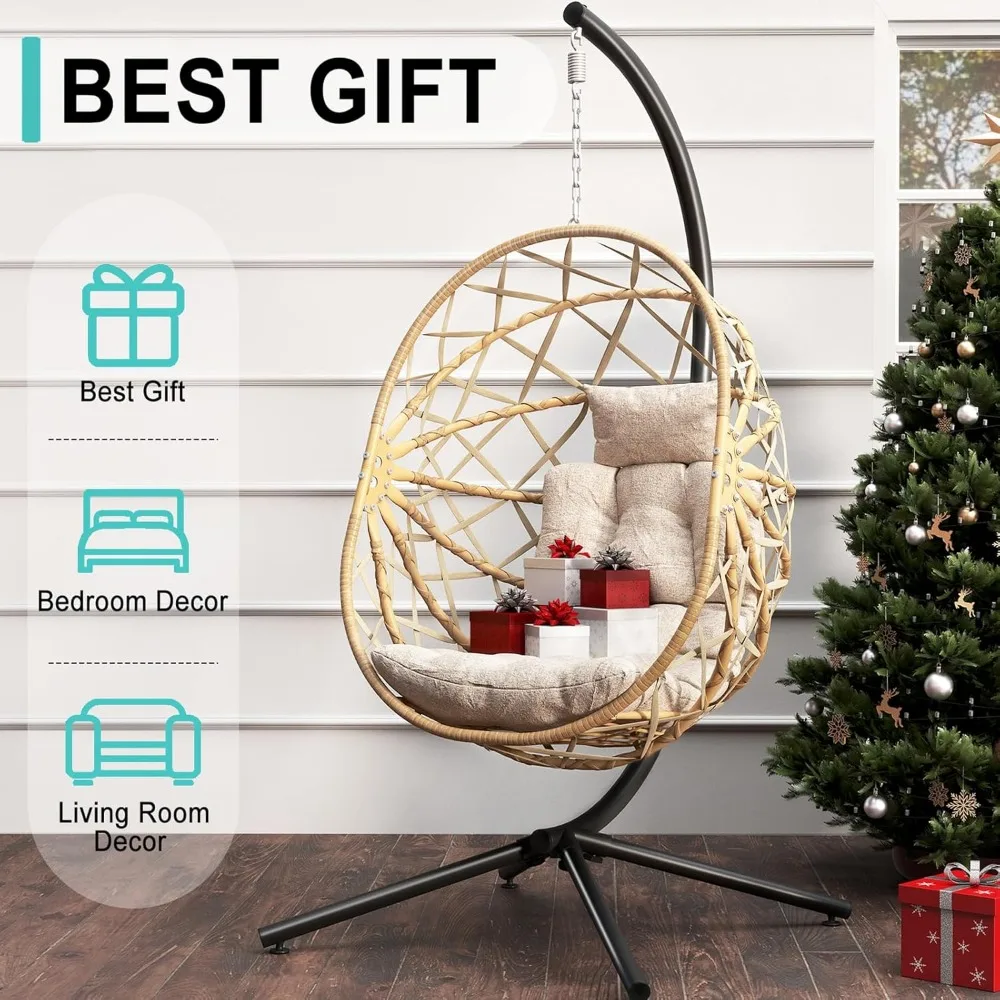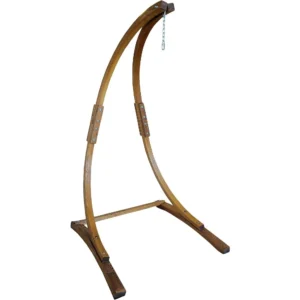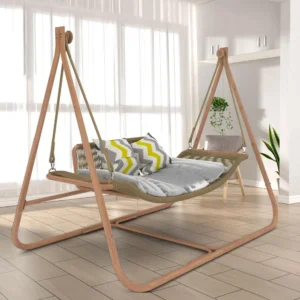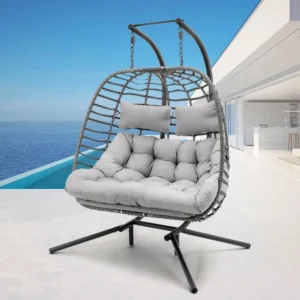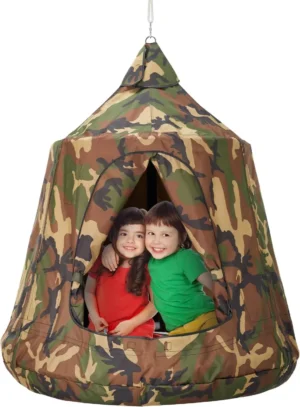Understanding Egg Chair Cushions: More Than Just Comfort
Egg chair cushions are far more than simple accessories—they’re essential components that transform your seating experience while protecting your investment. The right cushion serves dual purposes: providing the comfort that makes your egg chair a favorite relaxation spot and safeguarding the chair’s structure from wear and tear.
A well-chosen cushion can dramatically extend the lifespan of your egg chair. Studies suggest that proper cushioning can extend furniture longevity by 30-40%, making your investment last significantly longer while maintaining its aesthetic appeal. Beyond protection, quality cushioning transforms the entire feel of your chair, converting a rigid frame into a cozy sanctuary.
Whether you’re looking to replace an existing cushion or selecting one for a new purchase, understanding the nuances of egg chair cushions helps you make choices that align with your comfort preferences, design aesthetic, and practical needs. The perfect cushion balances:
- Support and softness for optimal comfort
- Durability for long-term use
- Materials appropriate for your environment
- Style that complements your space
As you explore hanging egg chair options, the cushion becomes a critical factor in your overall satisfaction with the chair. This guide will help you navigate the various options available, ensuring you find the perfect cushion for your needs.
Different Types of Egg Chair Cushion Materials
Cushion Fill Materials
The interior of your egg chair cushion largely determines how it feels when you sit and how long it maintains its shape. Different fill materials offer varying levels of support, resilience, and comfort:
Polyurethane Foam provides structured support with various density options. High-density foam (typically 2.0-3.0 pounds per cubic foot) offers firmer support that maintains its shape longer, while lower density options provide a softer, more plush feel. Foam cushions typically recover 95-98% of their original shape after use, making them excellent for maintaining appearance over time.
Polyester Fiberfill creates a soft, fluffy cushion that conforms to your body. This fill is lightweight and often less expensive than foam options, though it may compress more quickly over time. Fiberfill recovers approximately 70-85% after compression, requiring occasional fluffing to maintain its shape.
Memory Foam contours to your body’s unique shape, providing personalized support that many users find reduces pressure points. This premium material typically recovers more slowly (taking 5-10 seconds to return to shape) but offers excellent pressure distribution that many find worth the investment.
Eco-Friendly Alternatives include natural latex, recycled polyester, and even organic cotton fill. These sustainable options provide varying levels of support while reducing environmental impact, though they often come at a higher price point.
The density of your fill material significantly affects both comfort and durability. Higher density materials generally provide better support and last longer, though personal preference plays a major role in finding your ideal comfort level. Understanding these cushioned egg chair features helps in selecting the right combination for your needs.
Cushion Cover Fabrics
The exterior fabric of your egg chair cushion influences both comfort and longevity, particularly considering the curved design that requires materials with good stretch and recovery:
Polyester stands as the most common cushion cover material due to its durability and affordability. Modern polyester fabrics often score 25,000+ on the Martindale rub test (a standard measure of fabric durability), indicating excellent wear resistance. Polyester resists fading, dries quickly, and comes in countless colors and textures, making it versatile for most environments.
Cotton provides exceptional breathability and softness against the skin, creating a natural, cozy feel. While comfortable, cotton typically rates lower on durability tests (15,000-20,000 Martindale rubs) and may fade more quickly when exposed to sunlight. Cotton blends often offer a balance of comfort and improved durability.
Olefin (Polypropylene) excels in outdoor settings due to its inherent water and stain resistance. This synthetic fabric withstands harsh conditions without requiring additional protective treatments and typically achieves 30,000+ Martindale rubs. It resists moisture, mildew, and fading, making it ideal for egg chair cushions on patios.
Performance Fabrics like Sunbrella® combine the comfort of traditional fabrics with enhanced durability features. These premium options incorporate UV-resistant dyes and water-repellent treatments that are integrated into the fibers rather than applied as coatings. While more expensive, these fabrics often last significantly longer in challenging environments.
Fabric texture also influences the sensory experience, with options ranging from smooth microfibers to textured weaves that add visual and tactile interest to your egg chair setup.
Key Comfort Factors for Egg Chair Cushions
Thickness and Padding
The thickness of your egg chair cushion directly impacts how comfortable you’ll feel, especially during extended periods of relaxation. Most egg chairs benefit from cushions between 4-6 inches (10-15 cm) thick, providing enough depth to prevent “bottoming out” against the chair frame.
Research in seating ergonomics suggests that cushions should distribute weight evenly while providing adequate support for the natural curves of the body. This balance is particularly important for egg chairs, where the curved design already influences your sitting position.
Key thickness considerations include:
- Core thickness provides primary support and typically comprises the densest materials
- Top padding layers add softness and contouring for pressure relief
- Edge construction impacts how well the cushion maintains its shape at the periphery
- Compression over time varies by material quality and density
Many premium egg chair cushions feature multiple density zones, with firmer support where weight concentrates and softer areas for comfort. This design approach, similar to what you’ll find in the most comfortable hammock types, creates a seating experience that feels supportive yet plush.
The relationship between thickness and comfort isn’t always linear—extremely thick cushions can actually reduce comfort by changing the chair’s intended ergonomics. Finding the optimal thickness for your specific egg chair model ensures the best balance of support and comfort.
Cushion Shape and Design Features
The distinctive curved form of egg chairs demands thoughtfully designed cushions that follow their unique contours. While the basic egg chair cushion typically features a rounded shape that narrows toward the top, several design variations enhance the comfort experience:
Teardrop designs follow the natural egg shape while providing extra support at the base where weight concentrates. This shape naturally accommodates various sitting positions, from upright to reclined.
Contoured cushions incorporate ergonomic features like:
* Lumbar support bulges that maintain proper lower back curvature
* Neck support extensions that cradle the head and neck
* Side bolsters that provide gentle support for the arms and torso
Segmented designs use separate cushion panels that articulate with the chair’s movement, particularly beneficial for hanging egg chairs that swing or rotate.
Additional comfort features often include:
- Removable headrest pillows for customizable neck support
- Extended side wings that create a cocooning effect
- Integrated foot cushions for complete body support
These specialized design elements significantly enhance the seating experience, making your egg chair suitable for extended relaxation sessions. When browsing hanging egg chair sets, pay attention to these cushion design details as they dramatically influence overall comfort.
Indoor vs. Outdoor Egg Chair Cushions
Indoor Cushion Specifications
Indoor egg chair cushions prioritize comfort and aesthetics without the need for extensive weather protection. In climate-controlled environments, you can select materials primarily for their feel and appearance rather than durability against the elements.
For indoor use, consider these cushion characteristics:
- Softer fabrics like velvet, microsuede, or cotton blends that feel luxurious against the skin
- Decorative details such as tufting, piping, or contrast stitching that enhance visual appeal
- Lighter colors and patterns that might fade in outdoor settings but remain vibrant indoors
- Varied textures like ribbed corduroy or bouclé that add visual and tactile interest
Indoor cushion maintenance typically requires only regular vacuuming and occasional spot cleaning. For removable covers, follow the manufacturer’s washing instructions—typically gentle machine washing for synthetic fabrics and professional cleaning for natural fibers.
When selecting indoor cushions, consider how they complement your existing décor and the amount of natural light they’ll receive, as even indoor sunlight through windows can gradually fade certain materials. The versatility of indoor-outdoor hanging egg chairs allows you to select cushions that prioritize comfort and style for interior spaces.
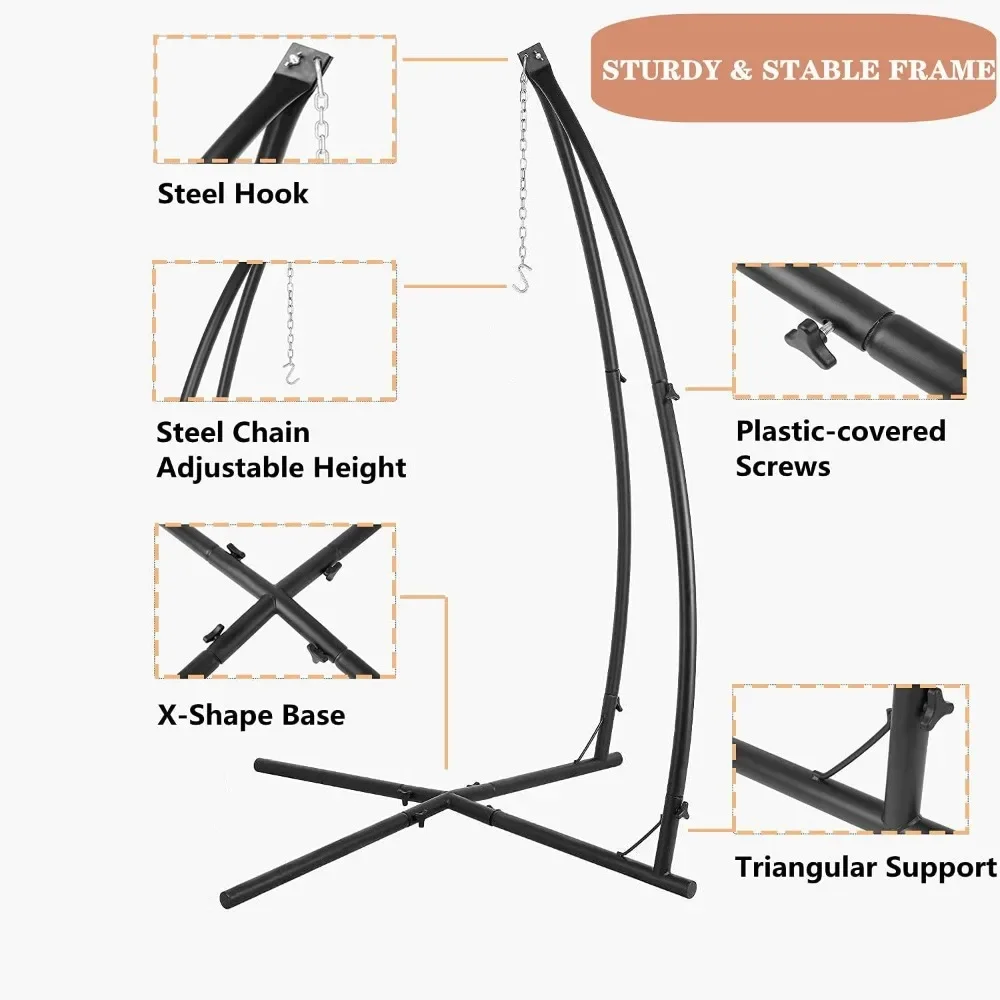
Weather-Resistant Outdoor Cushions
Outdoor egg chair cushions face significant challenges from sun, rain, temperature fluctuations, and environmental debris. Specialized materials and construction techniques help these cushions withstand these conditions while maintaining comfort.
Key features of quality outdoor cushions include:
- Weather-resistant fabrics with UV protection ratings of 500+ hours (indicating minimal fading after extensive sun exposure)
- Water resistance levels typically measured on a scale of 1-5, with outdoor cushions requiring at least a rating of 4 (resistant to moderate rain)
- Quick-dry foam cores with open-cell structures that allow water to flow through rather than being absorbed
- Antimicrobial treatments that prevent mold and mildew growth in humid conditions
Leading outdoor cushion materials include solution-dyed acrylics and certain polyester blends that incorporate UV stabilizers directly into the fiber during manufacturing rather than applying coatings that can wear off over time.
When selecting outdoor cushions, understand the difference between water-resistant options (which repel brief exposure to moisture) and fully waterproof designs (which prevent water penetration even during extended exposure). The latter typically feature internal waterproof membranes or entirely sealed construction.
The fabric features that enhance outdoor comfort in hammocks apply similarly to egg chair cushions, with durability against elements being paramount for extended lifespan.
Cushions for Different Egg Chair Styles
Hanging Egg Chair Cushions
Hanging egg chairs present unique cushioning challenges due to their suspended nature and dynamic movement. These chairs distribute weight differently than stationary models and require cushions designed specifically for stability during swinging or rotating motions.
Key considerations for hanging chair cushions include:
- Weight distribution that maintains balance during movement
- Non-slip backing materials that prevent cushion shifting
- Secure attachment points like ties, straps, or hook-and-loop fasteners
- Weight capacity matched to both chair and expected users (typically supporting 250-300 pounds)
The ideal thickness for hanging egg chair cushions typically falls between 4-5 inches (10-13 cm), providing enough cushioning without raising the sitter too high within the egg frame. Thicker cushions may elevate the user too much, while thinner ones might compress too fully under weight.
Many users find that cushions with a slightly firmer density work best in hanging models, as they maintain their shape better during the natural movement of the chair. If you enjoy different seating options, swinging hammock chair sets offer similar dynamic comfort with specialized cushioning requirements.
Standing Egg Chair Cushions
Standing egg chairs with fixed bases require cushions that maintain proper positioning while providing stable support. Without the movement of hanging models, these cushions focus more on contouring to the chair’s unique shape.
Standard egg chair cushion dimensions typically include:
- Base width: 20-24 inches (50-60 cm)
- Back height: 30-36 inches (75-90 cm)
- Seat depth: 18-22 inches (45-55 cm)
However, measurements vary significantly between manufacturers and specific models. Always measure your particular chair before purchasing replacement cushions.
Standing egg chair cushions often feature:
- Reinforced bottom panels that prevent sagging over the seat frame
- Contoured shapes that follow the precise curve of the chair
- Split designs that separate seat and back cushions for easier adjustment
- Integrated support in high-compression areas like the lower back and seat
The fixed nature of standing chairs allows for more precise cushion fitting, often resulting in a more tailored appearance than their hanging counterparts.
Double Egg Chair Cushions
Double egg chairs, designed to accommodate two people, require specially engineered cushions that provide consistent support across a larger surface area while preventing sagging or compression in the center where weight often concentrates.
These oversized cushions typically feature:
- Reinforced center sections with higher density foam to prevent bottoming out
- Weight support capacity of 450-600 pounds depending on construction
- Sectional designs that allow for easier fluffing and maintenance
- Multiple attachment points to prevent shifting during use
Manufacturers typically offer two cushion approaches for double chairs: split cushions (separate pieces for each user) or unified designs (single large cushion). Split cushions allow for individual adjustment and easier maintenance, while unified designs create a seamless appearance and prevent objects from slipping between cushions.
Similar construction principles apply to hammock chairs with stands designed for multiple users, where weight distribution remains a critical comfort factor.
Maintenance and Care for Longevity
Cleaning Different Cushion Materials
Regular cleaning dramatically extends the life of your egg chair cushions while maintaining their appearance and comfort. Different materials require specific cleaning approaches for best results:
For polyester covers:
1. Vacuum surface dust and debris using an upholstery attachment
2. Treat spots immediately with a solution of mild soap and warm water
3. Blot (don’t rub) stains with a clean, white cloth
4. Allow to air dry completely before replacing on the chair
For olefin/solution-dyed acrylic:
1. Remove loose soil by brushing or vacuuming
2. Mix 1/4 cup mild soap per gallon of lukewarm water
3. Clean with a soft brush, allowing solution to penetrate
4. Rinse thoroughly to remove all soap residue
5. Air dry only – never use high heat
For cushion fills:
1. Remove cover if possible
2. Spot clean foam or fiberfill with diluted fabric cleaner
3. Press (don’t wring) excess moisture with towels
4. Air dry completely before reassembling (may take 24-48 hours)
For stubborn stains or extensive soiling, professional cleaning may be necessary. Most manufacturers recommend cleaning outdoor cushions at least twice per season and indoor cushions once or twice annually, depending on use.
Understanding these maintenance requirements helps preserve all the benefits of egg-shaped hanging chairs through proper care of their cushions.
Storage and Protection Tips
Proper storage during off-seasons or extreme weather substantially extends cushion life, particularly for outdoor models:
- Store completely dry cushions in a cool, well-ventilated space to prevent mildew
- Use cushion storage bags with ventilation to allow air circulation while protecting from dust
- Maintain humidity levels below 65% in storage areas to prevent mold growth
- Elevate stored cushions off concrete floors to prevent moisture absorption
- Avoid compression under heavy objects during storage
For cushions that remain outdoors:
* Invest in waterproof cushion covers designed to fit over existing cushions
* Remove and store cushions during extended rainy periods or when not in use for several days
* Rotate cushions regularly to promote even wear and sun exposure
* Consider UV-protective sprays (reapply according to manufacturer guidelines)
Address minor damage promptly—small tears can quickly become larger issues when exposed to stress or weather. Simple repairs with appropriate outdoor fabric patches or seam sealers can significantly extend cushion life before replacement becomes necessary.
Similar protection strategies apply to cushions used in deep seat chair hammock sets, where exposure and usage patterns create comparable wear concerns.
Aesthetic Considerations: Style and Design
Color and Pattern Selection
The color and pattern of your egg chair cushion significantly impact both the chair’s appearance and how it integrates with your overall space. When selecting cushions, consider:
Color psychology influences how spaces feel—cool blues and greens create calm, relaxing environments, while warm oranges and yellows energize a space. Neutrals like beige, gray, and cream offer versatility and timeless appeal that works with changing décor.
Pattern scale matters in curved seating—medium-scale patterns typically work best on egg chairs, as very large patterns may become distorted across the curved surface, while tiny patterns can create visual busyness that overwhelms the chair’s elegant form.
Current trends favor:
* Natural, earthy tones that connect indoor spaces with nature
* Bold jewel tones that make a statement piece of the chair
* Classic stripes and geometric patterns that add visual interest
* Textural solids that provide subtle dimension without pattern
The egg chair often serves as a focal point in a room, so consider whether you want the cushion to blend harmoniously with surrounding décor or stand out as a statement piece. Thoughtful styling of hanging egg chairs extends to cushion selection as a key design element.
Texture and Visual Impact
Beyond color, the texture of your egg chair cushion adds substantial dimension to both the visual and tactile experience:
- Bouclé fabrics create a cozy, dimensional surface that adds warmth
- Flat weaves provide clean, contemporary lines with subtle texture
- Velvet and microsuede deliver rich depth and luxurious softness
- Performance fabrics can mimic natural materials while offering superior durability
Mixing textures—such as pairing a textured cushion with smooth chair materials or contrasting with nearby upholstery—creates visual depth that makes spaces more interesting. Consider how light interacts with different textures; materials like velvet or chenille change appearance as lighting shifts throughout the day.
The cushion’s texture significantly influences the overall sensory experience of the chair. Soft, plush textures invite longer sitting sessions, while more structured fabrics may provide better support for active seating positions.
Dark Wood Hammock Sets, Porch Swing Chair Sets
$653.82 Select options This product has multiple variants. The options may be chosen on the product pageA-Frame Stand Hammock Sets, Swinging Hammock Chair Sets
$154.62 Select options This product has multiple variants. The options may be chosen on the product pageLight Wood Hammock Sets, Swinging Hammock Chair Sets
$1,359.35 Select options This product has multiple variants. The options may be chosen on the product pageHammock Sets with Canopy, Heavy Duty Hammock Sets
$286.31 Select options This product has multiple variants. The options may be chosen on the product page- $963.29 Select options This product has multiple variants. The options may be chosen on the product page
Complete Camping Hammock Systems, Hanging Egg Chair Sets
$266.73 Select options This product has multiple variants. The options may be chosen on the product page
Finding the Perfect Replacement Cushion
Measuring for the Right Fit
Obtaining precise measurements ensures your replacement cushion fits properly and provides optimal comfort. Follow these steps for accurate dimensions:
Measure the seat width from the innermost point on one side to the corresponding point on the opposite side. For round bases, measure the diameter at the widest point.
Determine the back height from the lowest point where back and seat meet to the highest point of the chair back.
Measure the seat depth from the front edge to the point where the seat meets the backrest. For curved chairs, measure along the curve rather than a straight line.
Note any special contours or unique features that might affect cushion fit, such as dramatic curves or cut-outs.
Add 1-2 inches (2.5-5 cm) to each measurement if you prefer a fuller, more overstuffed appearance.
When replacing cushions for unusual or vintage models, consider creating a paper template that captures the exact shape needed. Most egg chairs fall within standard size ranges, but variations between manufacturers can be significant enough to affect comfort if not properly measured.
Similar measurement approaches apply to cushions for hammock sets with canopies, where proper fit ensures both comfort and stability.
Where to Find Quality Cushions
Quality egg chair cushions are available through various channels, each offering different advantages:
Furniture retailers and manufacturers often provide exact replacement cushions for their specific chair models, ensuring perfect fit but typically at premium prices ($150-300 for standard quality, $300-600 for premium options).
Specialty outdoor retailers offer weather-resistant options with extensive fabric selections, particularly beneficial for outdoor egg chairs requiring specific performance characteristics.
Custom upholstery services can create made-to-measure cushions for unusual sizes or vintage chairs, though costs typically run 30-50% higher than standard options.
Online marketplaces provide budget-friendly alternatives ($80-200), though quality and exact fit may vary. Always verify materials and measurements before purchasing.
When evaluating cushion quality before purchase:
* Check foam density specifications (higher numbers indicate firmer, more durable foam)
* Examine seam construction—double stitching indicates better durability
* Review fabric specifications for appropriate indoor/outdoor ratings
* Look for removable, washable covers that simplify maintenance
Value Considerations: Balancing Price and Quality
When investing in egg chair cushions, understanding the relationship between price and quality helps you make choices that provide the best long-term value. Different price tiers typically offer distinct benefits:
Budget cushions ($80-150) generally feature standard polyester covers and basic foam or fiberfill interiors. These typically last 1-3 years with regular use before showing significant compression or fabric wear. While affordable, these may require more frequent replacement, potentially costing more over time.
Mid-range options ($150-300) incorporate better materials like higher-density foams and more durable fabrics, extending lifespan to 3-5 years under normal conditions. This middle ground often provides the best balance between initial investment and longevity for most households.
Premium cushions ($300-600+) utilize top-tier materials like high-resilience foams, memory foam layers, and performance fabrics designed to withstand years of use. These can last 5-8+ years, making them potentially more economical despite higher upfront costs.
Consider your usage patterns when determining appropriate investment levels. Daily use in a primary seating area justifies spending more for durability, while occasional use in a secondary space might make budget options more sensible. Understanding whether hanging egg chairs are worth the money applies equally to their cushions—quality directly impacts long-term satisfaction and comfort.
Frequently Asked Questions
Can all egg chair cushions be used outdoors?
No, only cushions specifically designated as outdoor or all-weather should be used in exterior settings. Indoor cushions lack the UV protection, water resistance, and mildew prevention treatments necessary for outdoor durability. Using indoor cushions outside typically voids warranties and dramatically shortens their lifespan.
How often should I replace my egg chair cushion?
Quality indoor cushions typically last 3-5 years with regular use before losing significant support, while premium outdoor cushions may last 2-4 seasons depending on climate exposure. Replace cushions when they no longer return to their original shape after compression, develop persistent odors, or show significant wear that affects comfort.
Are egg chair cushions universal or chair-specific?
While some standard sizes exist, egg chairs vary significantly between manufacturers. Cushions designed specifically for your chair model provide the best fit and comfort. Universal cushions may work with minor adjustments but rarely offer the perfect fit of model-specific options.
How do I prevent cushion slippage in hanging chairs?
Look for cushions with non-slip backing materials, integrated ties or straps, or hook-and-loop attachment systems. Aftermarket cushion straps or furniture grip pads can also help secure existing cushions that tend to shift during use.
Can I wash my egg chair cushion in a washing machine?
Only if the manufacturer specifically states the cover is machine washable. Many cushion covers can be removed and machine washed on gentle cycles with mild detergent, but foam inserts should never be machine washed. Always check care labels and manufacturer instructions before washing any cushion components.

